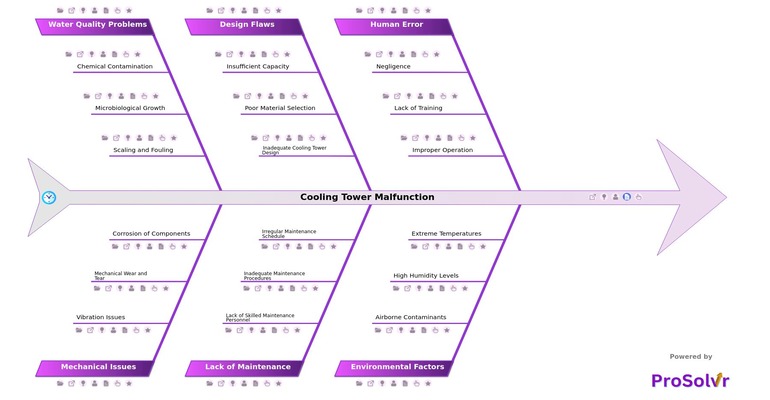RCA for Cooling Tower Malfunctions
Cooling towers are critical in petrochemical plants for managing heat generated during industrial processes. They help regulate the temperature of process fluids and equipment by dissipating excess heat into the atmosphere. This temperature control is essential for maintaining operational efficiency, preventing overheating, and ensuring the integrity of equipment. Effective cooling tower operation also contributes to overall plant safety, performance, and energy efficiency, as it helps maintain optimal conditions for chemical reactions and equipment function, thereby minimizing the risk of thermal damage or process upsets.
A malfunctioning cooling tower in a petrochemical plant can lead to severe consequences, including significant operational disruptions and increased safety risks. Cooling towers are critical for dissipating heat from the process systems, and their failure can cause overheating of equipment and process fluids. This overheating can, in turn, lead to reduced efficiency, potential damage to machinery, and even unplanned shutdowns, impacting production schedules and increasing operational costs. Additionally, if the cooling system is not functioning properly, it could result in the release of harmful emissions or pollutants, leading to environmental and regulatory compliance issues.
To address these issues effectively, a root cause analysis using a fishbone diagram can be highly beneficial. The fishbone template helps in systematically identifying and analyzing the various factors contributing to the cooling tower malfunction. By categorizing potential causes into groups, the analysis allows for a comprehensive examination of each area. This structured approach facilitates pinpointing the exact root causes, whether they involve mechanical failures, operational errors, or external factors. Consequently, it helps in developing targeted corrective actions, improving system reliability, and preventing future occurrences of similar problems.
Who can learn from the Cooling Tower Malfunction template?
Root Cause Analysis (RCA) of Cooling Tower Malfunction provides valuable insights for various stakeholder
- Maintenance Personnel: They can use the template to identify potential causes of cooling tower issues and develop more effective maintenance routines and troubleshooting strategies.
- Engineering Teams: Engineers can apply the template to design more robust cooling towers and address design flaws, ensuring better reliability and efficiency in the cooling system.
- Operational Managers: Managers responsible for overseeing plant operations can utilize the template to understand the impact of cooling tower malfunctions and implement procedures to mitigate risks and improve overall plant safety.
- Safety Officers: Safety officers can learn from the template to assess and address safety risks associated with cooling tower failures, ensuring compliance with safety regulations and protecting personnel.
- Training Coordinators: They can use the template to develop targeted training programs for staff on proper cooling tower operation, maintenance practices, and troubleshooting techniques.
- Quality Control Analysts: Analysts can use the template to identify and address water quality problems, ensuring that cooling systems operate effectively and meet quality standards.
Why use this template?
A Gen-AI powered Root Cause Analysis is crucial for addressing cooling tower malfunctions in a petrochemical plant as it provides a systematic approach to identifying the underlying causes of issues that can disrupt plant operations. By thoroughly investigating and understanding the root causes, such as design flaws, maintenance deficiencies, or environmental factors, RCA enables plant personnel to implement targeted corrective actions and preventive measures. This not only helps in resolving immediate problems but also in preventing future occurrences, thus enhancing the reliability and efficiency of the cooling system. Ultimately, effective RCA contributes to maintaining operational continuity, ensuring safety, and optimizing resource utilization, which are essential for the smooth and cost-effective operation of the petrochemical plant.
Draft and create a template for problem analysis in ProSolvr by smartQED.








